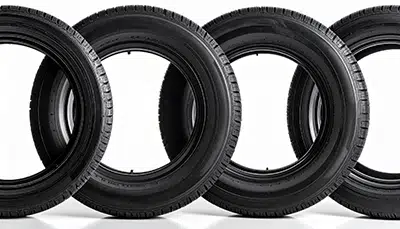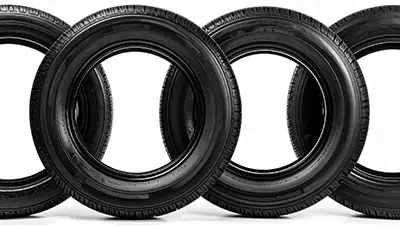The Right Tires Make All the Difference
Tires are your vehicle's only point of contact with the road, making them one of the most critical components for safety, performance, and comfort. At Custom Wheels N Tires, we offer an extensive selection of high-quality tires from leading manufacturers, ensuring you find the perfect match for your vehicle, driving conditions, and personal preferences.
Tire Types for Every Application
Different driving needs require specific tire designs. Our comprehensive inventory includes:
- All-Season Tires: Versatile options designed to perform reliably in various conditions throughout the year, offering a balanced combination of wet traction, dry grip, and light winter capability.
- Summer/Performance Tires: Engineered for maximum grip and responsive handling in dry and wet conditions, but not suitable for winter driving. Available in various performance levels from high-performance to ultra-high-performance for sports cars and enthusiast vehicles.
- Winter/Snow Tires: Specially formulated with unique tread patterns and rubber compounds that remain flexible in cold temperatures, providing superior traction on snow and ice.
- All-Terrain Tires: Designed for SUVs and trucks that split time between highways and off-road trails, offering good on-road manners with enhanced off-road capability.
- Mud-Terrain Tires: Aggressive tread patterns with large lugs and reinforced construction for serious off-road enthusiasts, providing maximum traction in mud, rocks, and other challenging terrain.
- Highway Tires: Specialized for trucks and SUVs primarily used on paved roads, offering improved comfort, reduced noise, and better fuel efficiency compared to all-terrain options.
- Touring Tires: Comfort-oriented tires with excellent road manners, reduced noise levels, and longer tread life, ideal for sedans and family vehicles.
Understanding Tire Specifications
Tire sizing and specifications can seem complex, but understanding these numbers ensures you select the correct tires for your vehicle:
- Tire Size (e.g., 245/45R18): The first number (245) indicates the tire width in millimeters. The second number (45) is the aspect ratio—the sidewall height as a percentage of the width. The letter R signifies Radial construction, and the last number (18) is the wheel diameter in inches.
- Load Index: A numerical code indicating the maximum weight each tire can support when properly inflated.
- Speed Rating: A letter code representing the maximum speed capability of the tire under ideal conditions.
- UTQG Rating: The Uniform Tire Quality Grading system provides ratings for treadwear (longevity), traction (grip on wet surfaces), and temperature resistance (heat dissipation).
Our tire experts can help you navigate these specifications to ensure you select tires that meet both your vehicle's requirements and your driving needs.
Tire Construction & Technology
Modern tires incorporate advanced engineering and materials to deliver exceptional performance:
- Tread Compounds: Specialized rubber formulations optimized for specific conditions—softer compounds for grip, harder compounds for longevity, and winter-specific compounds for cold-weather flexibility.
- Tread Patterns: Designed to channel water, provide biting edges for traction, reduce noise, and enhance stability. Patterns vary significantly between tire types to optimize for their intended use.
- Internal Construction: Multiple layers of specialized materials including steel belts, polyester, and nylon provide stability, strength, and comfort characteristics.
- Sidewall Design: Influences ride quality, handling response, and load-carrying capability. Some performance tires feature stiffer sidewalls for sharper handling, while touring tires may use softer sidewalls for improved comfort.
- Run-Flat Technology: Available on select models, allowing continued driving for a limited distance after a puncture, eliminating the need for immediate roadside tire changes.

Performance Considerations
When selecting tires, consider these key performance factors:
- Traction: The tire's ability to grip the road, affecting acceleration, braking, and cornering. Different tires prioritize traction in specific conditions (dry, wet, snow, off-road).
- Handling: How responsively the tire transfers steering inputs to the road. Performance-oriented tires typically offer sharper, more immediate response.
- Comfort: Ride quality and noise levels vary significantly between tire types. Touring and highway tires generally prioritize comfort, while performance and off-road tires may sacrifice some comfort for capability.
- Tread Life: Expected mileage before replacement. Typically, softer compounds that provide better grip wear faster than harder compounds designed for longevity.
- Fuel Efficiency: Low rolling resistance tires require less energy to move, potentially improving fuel economy.
- Seasonal Capability: Consider your local climate and whether you need year-round performance or season-specific tires for optimal safety and capability.
Tire Maintenance Essentials
Proper maintenance extends tire life and ensures optimal performance:
- Regular Pressure Checks: Maintain recommended pressure levels (found in your vehicle's owner's manual or door jamb sticker) for improved fuel economy, even wear, and optimal handling.
- Rotation Schedule: Rotate tires every 5,000-7,000 miles to promote even wear across all positions.
- Alignment Service: Proper wheel alignment prevents premature and uneven tire wear while improving handling and fuel efficiency.
- Tread Depth Monitoring: Replace tires when tread depth reaches 2/32" (or sooner for winter tires). The penny test is a simple way to check—if Lincoln's head is visible when inserted upside-down in the tread, it's time for replacement.
- Seasonal Inspection: Have your tires professionally inspected before extreme weather seasons to address any concerns before they become safety issues.
Key Takeaways
- Choose tire types based on your specific driving conditions, vehicle, and performance priorities.
- Understanding tire specifications ensures proper fitment and capability for your vehicle's requirements.
- Modern tire technology balances grip, comfort, durability, and fuel efficiency in various proportions.
- Regular maintenance including pressure checks, rotations, and alignments significantly extends tire life.
- Consider seasonal needs—dedicated winter tires provide substantial safety benefits in cold climates.

Frequently Asked Questions
How often should I replace my tires?
Most tires should be replaced when the tread depth reaches 2/32 of an inch, regardless of age. However, even if tread remains, tires should generally be replaced after 6-10 years due to rubber degradation. Regular inspections by a professional can help identify when replacement is necessary based on your specific tires and driving conditions.
Are all-season tires good enough for winter driving?
All-season tires provide adequate performance in light winter conditions, but they're a compromise by design. In regions with regular snow, ice, or temperatures consistently below 45°F, dedicated winter tires offer significantly better traction, shorter stopping distances, and improved safety. Think of all-season tires as "three-season tires" in areas with genuine winter conditions.
What's the difference between P-metric and LT tires?
P-metric (Passenger) tires are designed primarily for cars, minivans, and light-duty SUVs, prioritizing comfort, fuel economy, and on-road performance. LT (Light Truck) tires feature reinforced construction for higher load capacities and more robust durability, ideal for trucks, larger SUVs, and vehicles used for towing or hauling. LT tires typically have stiffer sidewalls and ride more firmly than their P-metric counterparts.
How does tire pressure affect performance?
Proper tire pressure is critical for optimal performance and safety. Underinflated tires can cause excessive heat buildup, reduced fuel economy, uneven wear, and compromised handling. Overinflated tires may provide less traction, a harsher ride, and uneven center-wear patterns. We recommend checking pressure monthly and before long trips, always when tires are cold, and maintaining the pressure specified by your vehicle manufacturer.
Can I mix different tire brands or models?
While it's best to use identical tires on all positions, if that's not possible, you should at minimum match tires across the same axle. Different models or brands can have varying handling characteristics, potentially creating unpredictable behavior, especially in emergency maneuvers or adverse conditions. If mixing becomes necessary, consult with our tire professionals to ensure the combinations won't compromise safety or vehicle performance.